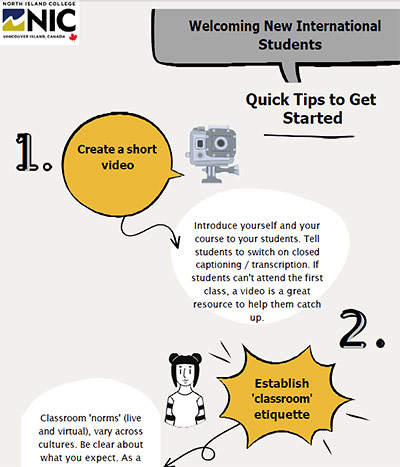Diverse Learning + Students
Recognizing that the concept of ‘diversity’ encompasses all the ways in which humans may differ from each other, this section focuses on resources aimed at supporting international students and / or students for whom English is an Additional Language (EAL). As humans we have complex identities that go beyond one or two ‘labels,’ therefore many of the resources included in this section will also be useful to consider for all learners.
Intercultural Classroom in Digital RealmTeaching online synchronously or asynchronously or just having components of learning happening digitally can present some new challenges and opportunities for teaching and learning. This handout shares some thoughts and suggestions for instructors.
|
Dimensions of CultureBeing more aware of culture and cultural perspectives, norms and expectations, teaching and learning experiences, especially working with students in group settings, can be misunderstood. Check out this handout on how dimensions of culture may influence group work with diverse learners.
|
Designing and Assessing Multicultural work
|
Students Working ON Group Projects
|
Engaging With Diverse LearnersThis is the first of two video presentations on Engaging With Diverse Learners. These videos focus on international students and students for whom English is an Additional Language, acknowledging that diversity includes all the ways in which we differ as humans. This first video highlights some of the challenges some students may experience in engaging in their learning and explores some general ways of fostering community and engagement across different delivery formats.
|
This is the second of two video presentations on Engaging With Diverse Learners. This second video explores what we mean by inclusive pedagogy and then looks at five principles of engagement with specific examples of activities that we can use that facilitate a variety of ways to support students in being active participants in their learning.
|
When we understand how culture may impact approaches to both teaching and learning, this section includes resources to support understanding classroom dynamics from different cultural perspectives and ways of engaging learners across diversity.
NIC INTERNATIONAL STUDENTS
Recorded in June 2022, this panel conversation includes four international students from Dubai, India, Iran, and the United States, along with Nadine, Global Engagement Liaison in the Office of Global Engagement. Together we discuss what it’s been like for them, coming to live and study in Canada. The students talk about the challenges of arriving during the pandemic, differences in their study experiences prior to coming to Canada, and what they enjoy at NIC and in Canada.
- Minutes 9–14 — The discussion begins with exploring the differences between studying at NIC and their previous experiences, including the impact of COVID restrictions, and their appreciation of the grading system at NIC
- Minutes 14 to 22 — The students talk about some of their struggles in adapting (including to online learning), the implications of inconsistencies in online course presentation across courses, differences in provision of textbooks, and the value of peer tutors.
- Minutes 22 — 27 — Other differences discussed include how there is a good integration of theoretical and applied learning at NIC, how some students are unused to a ‘non-cohort’ model of learning, and how hard instructors work to support students based on their individual needs
- Minutes 28 — 35 — The students chatted about some of the differences in classroom dynamics, including why some students don’t ask questions and may participate differently to how instructors sometimes expect
In the final few minutes, the discussion turns to external stressors that impact some students’ ability to focus on their studies, including differences in climate, immigration concerns, and the stress of not being able to easily access healthcare.
Meet our international Students
 In order to gain more of an idea of who our students are, in Fall 2022 we surveyed incoming students about:
In order to gain more of an idea of who our students are, in Fall 2022 we surveyed incoming students about:
-
- their beliefs / experiences about how they learn best
- what they hope to do after graduating from NIC
Our survey had a 27% response rate, which is lower than last year’s 38%. You can find the results of this survey in this PDF document: Meet Our New International Students Fall 2022
It’s also useful to know: Where-are-our-International-Students-Fall-2022 This infographic also provides some suggestions for teaching strategies to support diverse students.
Eight Tips for Supporting International Students
 Whether it’s your first time welcoming new international students into your class or you’re looking for something new to try, here are eight quick and easy tips for supporting new international students as they begin their studies here at NIC. Link to: NIC Eight Tips for Supporting International Students
Whether it’s your first time welcoming new international students into your class or you’re looking for something new to try, here are eight quick and easy tips for supporting new international students as they begin their studies here at NIC. Link to: NIC Eight Tips for Supporting International Students
If you’d like to chat about ideas specific to your class, please email Margaret at Margaret.Hearnden@nic.bc.ca